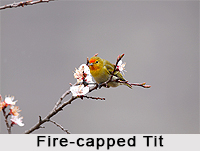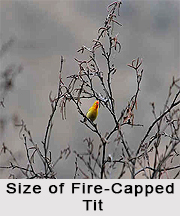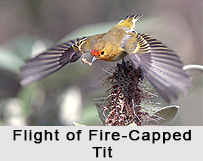 Fire-Capped Tit is an Indian bird that bears a scientific name "Cephalopyrus flammiceps" that belongs to the family of Remizidae.
Fire-Capped Tit is an Indian bird that bears a scientific name "Cephalopyrus flammiceps" that belongs to the family of Remizidae.
Structure of Fire-Capped Tit
Fire-Capped Tit is a small sized bird. This bird has the length of 10 centimetres or 3.9 inches, weighing 7grams and this bird species is assigned to the Remizidae family.
Breeding of Fire-Capped Tit
Fire-Capped Tit breeds in the temperate forests bordering the Himalayan Mountain Range to the south, in the Hengduan Shan and Nujiang Shan on the Myanmar-China border, the Micah Shan and Daba Shan on the Northern Sichuan border. In the winter season, Fire-Capped Tit downs from the hill and moves to further south. Further Fire-Capped Tit moves to the east. Fire-Capped Tit tends to be smaller in size and the plumage of Fire-Capped Tit becomes gradually darker.
Category of Fire-Capped Tit
Fire-Capped Tit was once considered to be a kinglet but is today treated as a Tit. It is placed in a monotypic genus, Cephalopyrus. Its previous assignment to the Remizidae family was not entirely satisfactory, as this species nests in hollows in trees, as do the true Tits and Chickadees (Paridae), so it was placed there. It also lays blue eggs, like the Verdin Auriparus flaviceps, and not white. Its small cone-shaped bill and its song however are typical for a Penduline Tit.
 Colour of Fire-Capped Tit
Colour of Fire-Capped Tit
Fire-Capped Tit has the crown, which is dark olive-brown, with a yellowish olive-green border. The upper parts are yellowish to olive-green. The rump of Fire-Capped Tit is yellowish to olive-golden yellow. The longest tail feathers of Fire-Capped Tit are dark grey. The tail of Fire-Capped Tit is dark olive-brown, all the feathers being tipped with white.
Wings of Fire-Capped Tit
The wings of Fire-Capped Tit are of the same colour as the tail, but with olive-yellow edging larger or smaller on all blankets and feathers. The throat of Fire-Capped Tit is white. Chest, belly and flanks show a yellow lemon, contrasting with the grey of the thighs, anal area and the underside of the tail.
Breeding Season of Fire-Capped Tit
In breeding plumage (February-July), the male Fire-Capped Tit has a slight orange-scarlet coloured crest.
Eye of Fire-Capped Tit
The eyebrow and around the eye of Fire-capped tit is golden yellow tinged with red.
Body of Fire-Capped Tit
The cheeks, ear coverts and sides of the neck of Fire-Capped Tit are olive-yellow. The chin and upper throat are orange chrome, melting into golden yellow chest. The sides of the chest and the upper sides are yellow-olive. The rear flanks and belly are pale yellow. The tips of the tail and wing feathers are white but worn.
 Sound of Fire-Capped Tit
Sound of Fire-Capped Tit
The calls of Fire-Capped Tit include a high-pitched but ample and jerky "tsit-tsit-tsit-tsit" at irregular intervals.
Nesting Season of Fire-Capped Tit
The nesting season of Fire-capped tit runs from early April to mid-June. The nest is built in a hollow inside a trunk or large branch. The fire-capped tit prefers cavities with their entrance protected by a branch or scar. It usually uses natural cavities but often takes over an abandoned woodpecker nest. Occasionally, a hollow is excavated where a rotting branch fell off. The nest, usually between 6 and 12 meters above the ground, is often very difficult to detect. The nest itself is a bowl built of dry grass, rootlets and sometimes a few feathers. It is lined with finer grasses and feathers. This is done by the female, while the male protects the territory. There are usually four dull blue-green eggs. The incubation period is unknown. If she is disturbed, she tries to deter the intruders by inflating her feathers and making hissing sounds. It is unknown if the male takes part in incubating. Youngsters are fed by both parents. The female takes care of maintenance and cleaning of the nest on her own.
Habitat of Fire-Capped Tit
Fire-Capped Tit occurs in forests, woodlands and regions with solitary trees. It prefers temperate rainforests and mixed deciduous forests with oak, hazel, elm and walnut, just below the conifer belt. At higher altitudes it frequents clusters of cherry and scattered willows. In Kashmir and Ladakh, Fire-Capped Tit nests in shrubs at high altitude.
Population of Fire-Capped Tit
The populations of the eastern Himalayan Mountain Range Fire-Capped Tit spend the period from November to May in southern Sikkim, between 300 and 1400 meters. In the far east of the breeding range, seasonal migration is less pronounced, and in Sichuan and Burma the birds remain during the winter at relatively high altitudes, around 1800 m. During the winter it is also found in evergreen broad-leaved forest in Thailand.



















